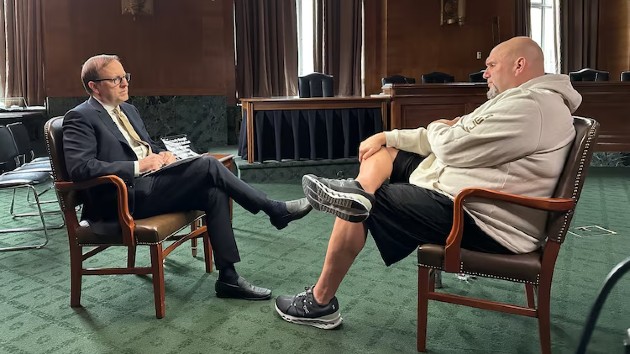From motherhood to medals: How Olympic moms return to competition
Written by ABC Audio. All rights reserved. on July 31, 2024

(NEW YORK) — Five-time Olympic swimmer Dara Torres felt nervous about asking her doctor if she could compete three weeks after giving birth.
Her doctor asked her to wait. She could start some light exercise tomorrow, though.
Torres, now the head coach of Boston College’s swimming and diving teams, remembers running into her doctor 10 days later at the gym.
“I don’t know if the endorphins were going, because I was at a gym and I was working out and I was feeling good,” Torres told ABC News. But she asked her doctor, “I have a meet in a week and a half. Can I swim in it?”
Torres did end up swimming in that meet. Her impressive performance there paved the way for her 2008 Olympic comeback only 16 months after giving birth.
The spotlight on elite athletes like Allyson Felix returning to competition after having a baby has contributed to increased resources for parents competing in the 2024 Paris Summer Olympics. However, shortfalls in research and guidance for athletes in the 12-week “postpartum” period following the birth of a child can hinder their return to competition and make it harder to achieve their peak performance.
Sparse advice for athletes post-childbirth
“There’s very little data out there about how postpartum women should progress, that’s supported by science. It’s mostly expert opinion,” said Dr. Ellen Casey, a sports medicine physician at the Hospital for Special Surgery.
This opinion is to listen to your body. “Your body’s going to tell you when you’ve pushed its limits,” said Dr. Melissa Simon, an OB-GYN at Northwestern Medicine.
“Just like if you’re trying to go from the couch to running a 5K, there’s a ramp up,” Simon said. “And for an athlete, that ramp up period obviously changes depending on the particular sport or event that they’re participating in.”
Olympian Ashley Twichell got back in the pool seven weeks after delivery. “I vividly remember my first day getting back in the water,” she told ABC News. Her time was slower than she hoped for. “My training times have never really gotten back to what they were pre-pregnancy,” but her competition times are catching up.
She remembers telling herself “this might be a little bit longer of a journey and maybe a little bit harder of a journey than I expected.”
Twichell is part of USA Swimming’s Board of Directors as the United States Olympic & Paralympic Committee Athletes’ Advisory Council representative.
Torres, on the other hand, said that her joints were more flexible after giving birth, and her swim times reflected this. “My body changed, but it was for the better,” she said.
At the 2008 Olympic Games in Beijing, Torres shaved time off the 50-meter freestyle performance at the 2000 Games in Sydney.
“I was probably in the best shape of my life after I had my daughter,” said Torres.
But the scientific jury is out on how pregnancy and childbirth affect performance. According to a review of the existing studies regarding postpartum performance in athletes, most were considered low quality.
One of the few studies to examine this question looked at the 150 best female marathoners worldwide. Of the 37 who had given birth, 70% posted their best times after giving birth.
More research is needed to understand how postpartum athletes should return to competitive sports, and “we have a long ways to go,” said Pamela Geisel. Geisel, an exercise physiologist, is the director of performance and wellness services at HSS.
Regaining core strength is key
The postpartum bounceback can be hard for athletes — and anyone for that matter — for a multitude of reasons: increased metabolic demands with breastfeeding, sleep deprivation and postpartum blues or depression.
Healing the pelvic floor and abdominal wall after delivery can be a particular problem for a lot of new moms.
Torres said “my core was so mushy,” after giving birth. This “mushiness” can be due to a condition called rectus diastasis, where the connective tissue between the abs muscles is separated or torn.
“Some statistics say that 100% of pregnant women will have some degree of separation,” in this connective tissue for the baby to grow, said Casey.
For 30% to 60% of postpartum women, the tissue doesn’t go back to how it was before pregnancy, Casey continued. However, “just because it’s common does not make it normal,” she emphasized.
Pelvic floor and core strengthening exercises can reduce pain and other complications from rectus diastasis, she said. Other experts say Kegels and squats can help strengthen the pelvic floor, while planks and crunches help the core.
“Strengthening the core was pretty key for me,” Torres agreed.
New taskforce advocates for more resources
The USPOC launched the Women’s Health Taskforce in 2022, which has focused on creating plans to support the women of Team USA. Casey is a part of this 16 person panel that has generated guidelines for postpartum return.
Advocacy for parent athletes resulted in the first ever Olympic village nursery. The nursery offers a childcare center, free diapers and wipes, and private spaces for breastfeeding.
“This is probably the most parent friendly Olympics ever,” said Simon.
However, Geisel said there is still much work to be done.
“We have a group of athletes that had to choose between becoming mothers or winning gold medals,” in the past, Geisel said. “I’m excited about the future and that women no longer will have to choose one or the other.”
Sejal Parekh, M.D., is a practicing pediatrician and a member of the ABC News Medical Unit.
Copyright © 2024, ABC Audio. All rights reserved.






